Benefits of Spaying After First Heat
Spaying a female dog or cat after their first heat cycle has numerous benefits for both the pet and their owner. In this article, we will explore the advantages of spaying your pet after their first heat, addressing common concerns and providing valuable information to help you make an informed decision.
Reduced Risk of Reproductive Disorders
Spaying your pet after their first heat greatly reduces the risk of various reproductive disorders. One such disorder is pyometra, a serious infection of the uterus that commonly affects unspayed female dogs and cats. Pyometra can be life-threatening if left untreated, requiring emergency surgery and intensive care. By spaying your pet after their first heat, you eliminate the risk of pyometra, ensuring their long-term health and well-being.
Prevention of Unwanted Pregnancies
Another significant benefit of spaying your pet after their first heat is the prevention of unwanted pregnancies. Female dogs and cats can become pregnant during their heat cycles, leading to unwanted litters. Overpopulation of pets is a serious issue, and by spaying your pet after their first heat, you contribute to reducing the number of homeless animals. Additionally, preventing pregnancies eliminates the stress and responsibility that comes with caring for a litter of puppies or kittens.
Elimination of Heat-Related Behaviors
Female dogs and cats experience behavioral changes during their heat cycles, including restlessness, increased vocalization, and attracting male animals. These behaviors can be challenging to manage and may disrupt the harmony of your household. By spaying your pet after their first heat, you eliminate these heat-related behaviors, allowing for a calmer and more balanced environment for both you and your pet.
Decreased Risk of Mammary Tumors
Spaying your pet after their first heat also significantly decreases the risk of mammary tumors, which are malignant or cancerous growths in the mammary glands. Studies have shown that the risk of developing mammary tumors in female dogs and cats increases with each heat cycle they experience. By spaying your pet early, you eliminate the hormonal changes associated with heat cycles, reducing the likelihood of mammary tumors and potentially saving your pet from a life-threatening condition.

Spaying your pet after their first heat offers numerous benefits, including a reduced risk of reproductive disorders, prevention of unwanted pregnancies, elimination of heat-related behaviors, and decreased risk of mammary tumors. By making the decision to spay your pet, you not only ensure their long-term health and well-being but also contribute to the overall welfare of animals by preventing overpopulation. Consult with your veterinarian to determine the best time for spaying your pet, and enjoy the peace of mind that comes with knowing you have made a responsible and beneficial choice.
Frequently Asked Questions
1. When is the best time to spay a female dog?
The ideal time to spay a female dog is before her first heat cycle. However, if you missed that window, it is still beneficial to spay her after her first heat.
2. What are the benefits of spaying a dog after her first heat?
Spaying a dog after her first heat can help prevent unwanted pregnancies, reduce the risk of certain cancers, and eliminate the need to manage her heat cycles.
3. Will spaying after the first heat eliminate the risk of mammary tumors?
While spaying after the first heat reduces the risk of mammary tumors, it may not eliminate it entirely. However, the risk is significantly lower compared to intact females.
4. Can spaying after the first heat help with behavior issues?
Spaying a dog after her first heat can help minimize certain behavior issues such as aggression, roaming, and excessive vocalization that may be associated with intact females.
5. Are there any health risks associated with spaying after the first heat?
The health risks associated with spaying after the first heat are generally minimal. However, it is always recommended to consult with a veterinarian to assess the individual risks and benefits for your dog.
6. Is the recovery period longer if a dog is spayed after her first heat?
The recovery period for spaying after the first heat is typically similar to spaying before the first heat. It may vary depending on the dog’s age, overall health, and the surgical technique used.
7. Can spaying after the first heat help prevent uterine infections?
Yes, spaying a dog after her first heat eliminates the risk of uterine infections (pyometra), which can be life-threatening if left untreated.
8. Will spaying after the first heat affect my dog’s weight?
Spaying a dog after her first heat may slightly increase the risk of weight gain. However, this can be managed through a balanced diet and regular exercise.
9. Can I still spay my dog if she has already had multiple heats?
Yes, you can still spay your dog even if she has had multiple heats. Spaying after the first heat is beneficial and can help improve her overall health and well-being.
10. Should I consult a veterinarian before deciding to spay my dog after her first heat?
Yes, it is highly recommended to consult a veterinarian before making any decisions regarding spaying your dog after her first heat. They can provide personalized advice based on your dog’s specific needs and circumstances.




